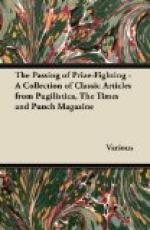My aunt said it would be cruel. It was certainly rough on me. Nibletts apologetically directed me to blow an egg—“a shop ’un ’d do.” Accordingly, following his instructions, I injected or otherwise introduced the ingredients through a small aperture. It was the bread-crumbs that gave me most trouble; but it was the photographic ammonia that was “cruel.” The mustard went in quite easily with a squirt.
I stopped the holes with paper stuck on with sealing-wax and put the oeuf farci in the run. I waited to see what would happen. It happened at once. All ten hens went for that egg in a convergent attack, and all ten pecks got home simultaneously. The deputation then hurriedly withdrew, with loud protests, and spent the rest of the day wiping their beaks in the cool earth.
But they remained recalcitrant. They systematically cannibalized. A cackle from the layer brought all the rest to the spot; and I simply couldn’t stay there all day to forestall the onslaught.
Nibletts suggested our getting a patent laying-box, furnished with (what he apologised to my aunt for calling) a false front. My aunt did not at first grasp the idea, but what Nibletts did in fact refer to was a contrivance that would admit one sitter only at a time, subsequent unauthorised entrance being cut off by an ingenious drop slide. Further elaborate construction also prevented the sitter herself from turning round to peck. She had to remain sitting till some human came and lifted her out.
Just one egg was laid in that patent box. The object of it was also patent—to the hens. Nothing would induce them to use it after that once.
Nibletts then recommended (if he might so describe it) a “tit-up.” That was, so to speak, a conjuring-trick of a laying-box, which let the egg fall through a trap-door into a padded cell beneath. My aunt thought it unnatural and feared that it might be exhausting. Nevertheless we tried it, and extracted one solitary egg from the basement.
Then, being an engineer by profession, I conceived a mechanical means of giving those hens the scare of their lives if they persisted in their antisocial habits. I constructed a “spoof” egg of white enamelled metal, with hinges that opened when a catch was touched. Inside I compressed one of those jack-in-the-box snakes that spring out when free to do so.
It was quite effective—as a parlour-trick. Those hens pecked the catch loose, and that cockatrice fairly staggered them. It was to them a clear case of “nourishing a viper.” But all was as before.
Nibletts then gave up the case as (what he might be excused for calling) a “fair corker.” Should he wring their (pause) necks?
We thought it best so, and gave him a couple of “laying pullets” for his trouble. The other eight kept us going monotonously for about a month.
The house is still on offer. Houses are scarce just now.




